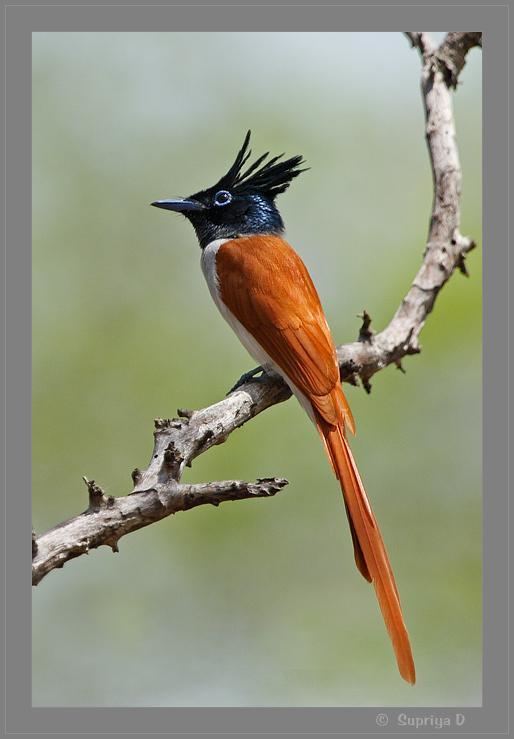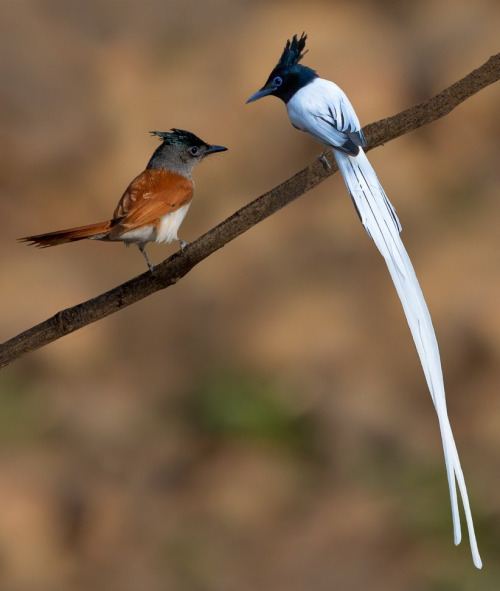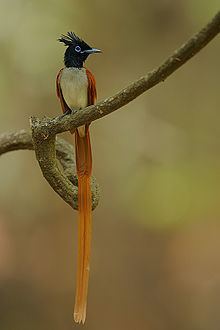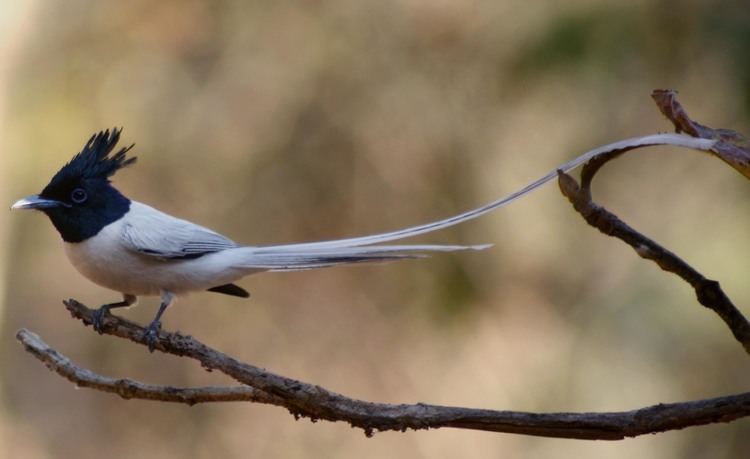Higher classification Paradise flycatcher | Scientific name Terpsiphone paradisi Rank Species | |
 | ||
Similar Paradise flycatcher, Bird, Japanese paradise flycatcher, Monarch flycatcher, Passerine | ||
Indian paradise flycatcher
The Indian paradise flycatcher (Terpsiphone paradisi) is a medium-sized passerine bird native to Asia that is widely distributed. As the global population is considered stable, it has been listed as Least Concern on the IUCN Red List since 2004. It is native to the Indian subcontinent, Central Asia and Myanmar.
Contents
- Indian paradise flycatcher
- Taxonomy and systematics
- Subspecies
- Description
- Distribution and Habitat
- Behaviour and Ecology
- References

Males have elongated central tail feathers, and a black and rufous plumage in some populations, while others have white plumage. Females are short-tailed with rufous wings and a black head. Indian paradise flycatchers feed on insects, which they capture in the air often below a densely canopied tree.

Taxonomy and systematics

The Indian paradise flycatcher was originally described as belonging to the genus Corvus. Paradise-flycatchers used to be classified with the Old World flycatcher family Muscicapidae, but are now placed in the family Monarchidae together with monarch flycatchers.

Until 2015, the Indian paradise flycatcher, the Oriental paradise flycatcher, and the Amur paradise flycatcher were all considered conspecific, and together called the Asian paradise flycatcher.
Subspecies
Three subspecies are recognized:

Description
Adult Indian paradise flycatchers are 19–22 cm (7.5–8.7 in) long. Their heads are glossy black with a black crown and crest, their black bill round and sturdy, their eyes black. Female are rufous on the back with a greyish throat and underparts. Their wings are 86–92 mm (3.4–3.6 in) long. Young males look very much like females but have a black throat and blue-ringed eyes. As adults they develop up to 24 cm (9.4 in) long tail feathers with two central tail feathers growing up to 30 cm (12 in) long drooping streamers.
Young males are rufous and have short tails. They acquire long tails in their second or third year. Adult males are either predominantly bright rufous above or predominantly white. Some specimens show some degree of intermediacy between rufous and white. Long-tailed rufous birds are generally devoid of shaft streaks on the wing and tail feathers, while in white birds the shaft streaks, and sometimes the edges of the wing and tail feathers are black.
In the early 1960s, 680 long-tailed males were examined that are contained in collections of the British Museum of Natural History, Chicago Natural History Museum, Peabody Museum, Carnegie Museum, American Museum of Natural History, United States National Museum and Royal Ontario Museum. The specimens came from almost the entire range of the species, though some areas were poorly represented. The relative frequency of the rufous and white plumage types varies geographically. Rufous birds are rare in the extreme southeastern part of the species' range. Throughout the Indian area and, to a lesser extent, in China, asymmetrically patterned intermediates occur. Intermediates are rare or absent throughout the rest of the range of the species. In general, long-tailed males are
Possible interpretations of this phenomenon are : males may be polymorphic for rufous and white plumage colour; rufous birds may be sub-adults; and there may even be two sympatric species distinguishable only in the male.
Distribution and Habitat
They are migratory and spend the winter season in tropical Asia. There are resident populations in southern India and Sri Lanka, hence both visiting migrants and the locally breeding subspecies occur in these areas in winter.
According to Linné’s first description Indian paradise flycatchers were only distributed in India. Later ornithologists observed this spectacular bird in other areas, and based on differences in plumage of males described several subspecies.
Indian paradise flycatchers inhabit thick forests and well-wooded habitats from Central Asia to south-eastern China, all over India and Sri Lanka to Myanmar.
Behaviour and Ecology
Indian paradise flycatchers are noisy birds uttering sharp skreek calls. They have short legs and sit very upright whilst perched prominently, like a shrike. They are insectivorous and hunt in flight in the understorey. In the afternoons they dive from perches to bathe in small pools of water.
The breeding season lasts from May to July. Being socially monogamous both male and female take part in nest-building, incubation, brooding and feeding of the young. The incubation period lasts 14 to 16 days and the nestling period 9 to 12 days. Three or four eggs are laid in a neat cup nest made with twigs and spider webs on the end of a low branch. The nest is sometimes built in the vicinity of a breeding pair of drongos, which keep predators away. Chicks hatch in about 21 to 23 days. A case of interspecific feeding has been noted with paradise flycatcher chicks fed by Oriental white-eyes.
